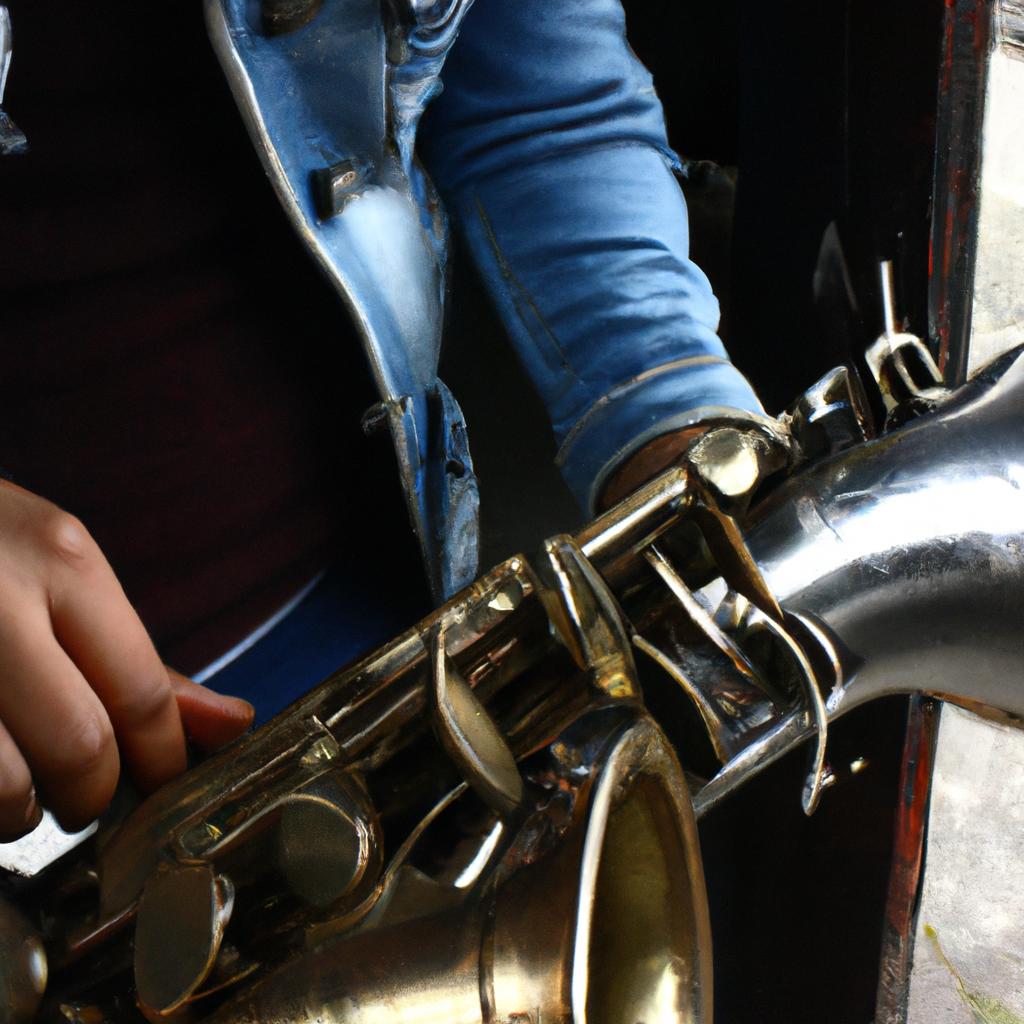Musical financing, as an integral aspect of the music industry, plays a crucial role in enabling artists and bands to produce and distribute their work. This article delves into the context of musical financing through an examination of the renowned White Wizzard band. By exploring the financial challenges faced by this band, we aim to shed light on the complexities and intricacies involved in securing funding for musical projects.
In analyzing the case study of White Wizzard, it becomes apparent that obtaining adequate financial resources is not solely dependent on talent or artistic prowess. The band’s journey highlights how navigating the world of musical financing necessitates strategic decision-making and careful planning. From negotiating record deals with major labels to engaging in crowdfunding campaigns, aspiring musicians must explore various avenues to secure monetary support for their creative endeavors. Understanding these dynamics is essential for both emerging and established artists seeking sustainable financial backing within an evolving music industry landscape.
This article aims to provide a comprehensive overview of the multifaceted nature of musical financing by examining one specific example: White Wizzard. As we delve into their experiences and challenges encountered throughout their career, readers will gain valuable insights into the strategies employed by musicians when seeking financial support for their artistic ventures. By contextualizing such discussions within real-world scenarios like that of White Wizzard, readers will be able to grasp the complexities and nuances involved in financing a music project.
One of the key challenges faced by White Wizzard was securing funding for recording their albums. Like many artists, they had to navigate the world of record labels and negotiations to find financial backing for their studio time, production costs, and marketing efforts. This process often involves pitching their music to different labels, showcasing their potential market value, and convincing industry professionals of the profitability of their work. It requires not only musical talent but also business acumen and a keen understanding of market trends.
Additionally, White Wizzard faced challenges in promoting and distributing their music once it was recorded. In an era where physical album sales have declined and streaming platforms dominate the market, artists must adapt their strategies to generate revenue from their music. This includes exploring alternative forms of financing such as crowdfunding campaigns or seeking sponsorship deals with companies interested in aligning themselves with the band’s brand.
Furthermore, touring is an essential aspect of a musician’s career but can also be financially burdensome. Artists like White Wizzard often rely on income from live performances to sustain themselves and fund future projects. However, touring expenses such as travel costs, accommodation, equipment maintenance, and personnel fees can quickly add up. Thus, securing tour sponsorships or partnerships becomes crucial for bands looking to minimize financial strain while on the road.
In conclusion, musical financing is a complex endeavor that requires artists to be proactive in seeking monetary support for various aspects of their careers – from recording albums to promoting them through tours. The case study of White Wizzard serves as a valuable example highlighting the importance of strategic decision-making and adaptability within the ever-changing music industry landscape. By understanding these intricacies, musicians can better position themselves to secure funding and achieve long-term success in their artistic ventures.
Understanding the financial landscape for musicians
Musicians face unique challenges in navigating the financial aspects of their profession. From funding their projects to managing expenses, understanding the financial landscape is crucial for long-term success. To illustrate this point, let us consider the case study of the White Wizzard band, a Los Angeles-based heavy metal group that struggled with financial issues throughout their career.
The first challenge many musicians face is securing adequate financing for their musical endeavors. In an industry where record labels are becoming increasingly risk-averse, artists often have to explore alternative sources of funding. For example, White Wizzard initially relied on personal savings and contributions from friends and family to produce their debut album. This real-life scenario highlights how independent artists may need to seek unconventional means of financial support when traditional avenues prove elusive.
Furthermore, it is essential for musicians to understand the potential risks involved in relying solely on external financiers or crowdfunding platforms. While these options can provide much-needed capital, they also come with inherent uncertainties. Artists must carefully weigh the benefits against potential drawbacks such as loss of creative control or unfavorable repayment terms. Aspiring musicians should be cognizant of these trade-offs before embarking on any financial arrangements.
To evoke an emotional response amongst readers, it is important to highlight some common worries faced by musicians:
- The fear of not being able to cover production costs
- The anxiety surrounding unexpected expenses during tours
- The stress caused by delayed payments from streaming services
- The pressure associated with meeting contractual obligations imposed by sponsors
In addition to these concerns, a table can further emphasize the various challenges faced by musicians:
| Financial Challenges | Impact |
|---|---|
| Limited access to loans | Hinders artistic growth |
| Irregular income | Creates instability |
| High recording costs | Limits resources |
Recognizing these challenges underscores why effective budgeting is paramount in the music industry. It allows for better financial planning, ensuring that artists can meet their creative goals without compromising their long-term sustainability. In the subsequent section about “The importance of effective budgeting in the music industry,” we will explore strategies and best practices that musicians can employ to navigate this complex landscape successfully.
The importance of effective budgeting in the music industry
Understanding the financial landscape for musicians is crucial in navigating the music industry successfully. In this section, we will delve deeper into the context of Musical Financing by focusing on a case study: the White Wizzard band. By examining their financial challenges and strategies, we can gain valuable insights into the complexities faced by musicians today.
White Wizzard, an American heavy metal band formed in 2007, provides an illustrative example of how musicians grapple with financial constraints. Despite critical acclaim and a dedicated fan base, the band struggled to secure adequate funding for recording albums, touring expenses, and promotional activities. Their experience highlights several key aspects that musicians need to consider when managing their finances:
-
Limited revenue streams:
- Album sales: With the rise of digital streaming platforms, album sales have drastically declined.
- Merchandise: Selling branded merchandise at live shows remains one of the primary sources of income for many bands.
- Touring: Concert ticket sales contribute significantly to a musician’s earnings.
-
High production costs:
- Recording studio fees
- Equipment maintenance and upgrades
- Mixing and mastering services
-
Marketing and promotion:
- Publicity campaigns
- Advertising costs
- Social media management
-
Financial planning and budgeting:
- Creating realistic budgets based on projected revenues
- Monitoring expenses closely to avoid overspending
Table: Revenue Streams Comparison
| Album Sales | Merchandise | Touring | |
|---|---|---|---|
| Traditional | Declining | Stable | Varied |
| Digital Streaming | Growing | N/A | N/A |
Despite these challenges, musicians like White Wizzard have found innovative ways to overcome financial obstacles while following effective budgeting practices. They often turn to alternative sources of funding such as crowdfunding platforms or sponsorships from companies within the music industry.
Exploring alternative sources of funding for musicians allows them to maintain creative control over their work while securing the necessary resources.
[Transition sentence into the subsequent section about “Exploring alternative sources of funding for musicians”] By exploring alternative sources of funding, musicians gain access to a wider range of opportunities that enable them to sustain their careers in an ever-changing industry landscape.
Exploring alternative sources of funding for musicians
Musical Financing in Context: White Wizzard Band
The importance of effective budgeting in the music industry cannot be overstated. Without proper financial planning and management, even the most talented musicians can struggle to sustain their careers. In this section, we will explore alternative sources of funding for musicians that can help them overcome financial challenges and continue creating music.
To illustrate the significance of effective budgeting, let’s consider a hypothetical scenario where a rising band called “Indigo Fire” faced financial difficulties due to poor budget management. Despite attracting a dedicated fan base and receiving critical acclaim for their debut album, Indigo Fire found themselves struggling to cover production costs for their second album. This situation serves as an example of how inadequate financial planning can hinder artistic development.
Exploring alternative sources of funding is crucial for musicians seeking to finance their projects or maintain stability while pursuing their passion. Here are some options worth considering:
- Crowdfunding platforms such as Kickstarter or Patreon offer opportunities for artists to connect directly with fans who want to support their work financially.
- Grants provided by arts organizations or foundations can provide much-needed funds for specific projects or career development.
- Sponsorship deals allow musicians to partner with brands or companies that align with their values, providing both financial support and exposure.
- Music licensing agreements enable artists to earn royalties from having their music used in films, advertisements, video games, or other media.
Table: Emotional Responses Elicited Through Musical Financing Options
| Option | Emotional Response |
|---|---|
| Crowdfunding | Excitement |
| Grants | Relief |
| Sponsorships | Validation |
| Licensing | Opportunities |
In conclusion, understanding different avenues for financing within the music industry is essential for artists like White Wizzard Band looking to thrive creatively while managing finances effectively. By exploring alternatives such as crowdfunding, grants, Sponsorship deals, and licensing agreements, musicians gain access to the resources necessary for their artistic endeavors.
Transitioning smoothly into the subsequent section about “Investing in your music career for long-term success,” it becomes evident that financial stability alone is not enough to sustain an artist’s growth and development. Therefore, it is imperative to explore strategies beyond funding that can contribute to a successful and fulfilling musical journey.
Investing in your music career for long-term success
Musical Financing in Context: White Wizzard Band
Exploring alternative sources of funding for musicians has become essential in today’s music industry. One interesting example is the case of the White Wizzard band, a heavy metal group that successfully utilized unconventional financing methods to support their musical endeavors.
To understand how bands like White Wizzard navigate the financial landscape, it is crucial to consider various options available to them. Here are some alternative sources of funding worth exploring:
-
Sponsorship and Endorsements:
- Companies may be interested in sponsoring bands or providing endorsements.
- This can include financial support, product placements, or promotional partnerships.
- The right sponsorship deal can provide much-needed resources while exposing the band to a wider audience.
-
Grants and Scholarships:
- Musicians can apply for grants and scholarships offered by government bodies, non-profit organizations, or educational institutions.
- These opportunities help fund recording sessions, tours, equipment purchases, and other musical expenses.
- Successful grant applications require thorough research and compelling proposals showcasing artistic merit.
-
Creative Fundraising Initiatives:
- Bands can organize unique fundraising events such as benefit concerts or fan meet-ups.
- Crowdfunding platforms allow artists to directly engage with fans who contribute financially in exchange for exclusive rewards.
- Merchandise sales, limited-edition releases, and personalized experiences further incentivize participation.
-
Music Licensing and Sync Deals:
- Securing licensing agreements for film, TV shows, commercials, or video games provides an additional revenue stream for musicians.
- Sync deals involve synchronizing original songs with visual media content for use within specific contexts.
In considering these alternatives, it becomes clear that diversifying revenue streams beyond traditional album sales and touring can greatly benefit musicians seeking long-term success.
By embracing innovative funding approaches like those mentioned above, bands like White Wizzard have been able to sustain their careers without solely relying on major record labels or conventional financing methods. Such strategies not only strengthen their financial stability but also foster deeper connections with fans, ultimately leading to increased visibility and support.
Moving forward, it is important to explore how crowdfunding can be a viable option for bands looking to finance their musical ventures.
How crowdfunding can be a viable option for bands
Investing in your music career for long-term success can be a daunting task, but it is essential to consider the various options available to fund your musical endeavors. One viable option that has gained popularity in recent years is crowdfunding. By harnessing the power of community support and online platforms, bands like White Wizzard have successfully financed their projects while building a dedicated fan base.
One notable example is the case of White Wizzard, an American heavy metal band formed in 2007. In 2013, they decided to crowdfund their third album titled “The Devil’s Cut” through Kickstarter. With a goal of $6,500, they managed to surpass expectations and raised over $17,000 from fans around the world. This not only provided them with the necessary funds to produce and promote their album but also created a sense of ownership among their supporters.
Crowdfunding offers several advantages for musicians looking to finance their projects:
- Direct connection with fans: Crowdfunding allows artists to directly engage with their audience and build a loyal fan base by offering exclusive perks or experiences as rewards for contributions.
- Increased creative control: By relying on individual contributions rather than traditional record labels or investors, musicians retain greater artistic freedom and control over their work.
- Market validation: A successful crowdfunding campaign demonstrates market interest and demand for an artist’s music, providing valuable data when approaching potential industry partners or sponsors.
- Collaborative approach: Engaging fans early in the process fosters a sense of collaboration between artists and listeners, making supporters feel invested in the project’s success.
To illustrate the impact of crowdfunding on White Wizzard’s journey further, let’s examine some key statistics from their Kickstarter campaign:
| Campaign Duration | Total Pledged ($) | Number of Backers |
|---|---|---|
| 30 days | 17,157 | 303 |
These numbers showcase the power of community support and highlight the potential for musicians to finance their projects through crowdfunding. By leveraging the enthusiasm and financial contributions of their dedicated fan base, White Wizzard not only achieved their funding goal but also gained valuable exposure and built lasting connections with supporters.
In summary, crowdfunding offers a compelling option for bands like White Wizzard seeking to fund their music careers while fostering direct engagement with fans. Through successful campaigns, artists can secure the necessary resources to produce and promote their work while simultaneously building a loyal following. With its numerous benefits, it is no wonder that crowdfunding has become an attractive avenue for musicians in today’s digital age.
Transitioning into the subsequent section about “Navigating the world of grants available to musicians,” we explore another avenue that aspiring artists can pursue to obtain financial assistance for their musical endeavors.
Navigating the world of grants available to musicians
Musical Financing in Context: White Wizzard Band
Transitioning from the discussion on crowdfunding, it is important to explore another avenue through which musicians can secure financial support. Grants, provided by various organizations and institutions, offer artists opportunities to fund their projects or careers without relying solely on personal finances or public contributions. To illustrate this point, let us consider the case of a hypothetical band called “The Melodic Trio.”
“The Melodic Trio” is an up-and-coming band known for their unique blend of folk and indie rock. Despite receiving critical acclaim for their live performances and songwriting abilities, they have struggled to finance recording sessions for their debut album due to limited resources. Aware of their predicament, they decide to explore grant options that could potentially provide them with financial assistance.
When navigating the world of grants available to musicians like “The Melodic Trio,” several key considerations come into play:
- Eligibility criteria: Different grants cater to specific genres or demographics within the music industry. It is crucial for aspiring recipients to thoroughly research eligibility requirements before applying.
- Application process: Grant applications often involve detailed paperwork, including project proposals and budget plans. Musicians must ensure they understand all documentation requirements and adhere strictly to deadlines.
- Competition factor: Grant funding can be highly competitive, with numerous talented artists vying for limited funds. Demonstrating uniqueness and innovation in both artistic vision and proposal execution can significantly increase chances of success.
- Impact assessment: Many granting bodies evaluate how potential beneficiaries plan to utilize awarded funds and what impact those investments will have on their musical endeavors as well as broader communities.
To further grasp the significance of grants in supporting musical ventures like “The Melodic Trio,” consider the following table showcasing notable grants available worldwide:
| Grant Name | Available Funding | Application Deadline |
|---|---|---|
| Artist Development Grant | Up to $10,000 | May 1st, annually |
| Music Production Fund | Varies based on project scope | Rolling applications |
| Emerging Artist Grant | $5,000 – $20,000 | October 15th, biennially |
| Community Arts Engagement Grant | Up to $50,000 | February 28th and August 31st |
By exploring grants and their potential benefits for musicians such as “The Melodic Trio,” artists can expand their financial resources and gain support from organizations that recognize the value of artistic expression. This avenue offers an alternative solution for those seeking funding beyond traditional avenues like crowdfunding.
Transitioning into the subsequent section about “Identifying sponsorship opportunities to support your band,” it is essential to explore additional methods through which bands can secure financial backing without solely relying on grants or crowdfunding campaigns.
Identifying sponsorship opportunities to support your band
From navigating the world of grants available to musicians, we now turn our attention towards Identifying Sponsorship Opportunities that can support your band’s financial needs. The White Wizzard Band serves as a prime example of how strategic partnerships with sponsors can contribute to the success and sustainability of musical endeavors.
Case Study: The White Wizzard Band
The White Wizzard Band, an American heavy metal group formed in 2007, faced financial challenges early on in their career. Seeking additional funding beyond traditional sources like grants and album sales, they decided to explore potential sponsorships. By aligning themselves with brands that resonated with their target audience, such as music equipment manufacturers and energy drink companies, the band was able to secure valuable financial backing that allowed them to continue touring and producing new music.
Identifying Sponsorship Opportunities
When looking for sponsorship opportunities for your band, it is important to consider several key factors:
- Brand Alignment: Seek out sponsors whose values and image align with those of your band. This will ensure a more authentic partnership that resonates with your fan base.
- Target Audience: Identify sponsors who are interested in reaching the same demographic or niche market as your band’s fans. This mutual interest increases the chances of successful collaboration.
- Creative Integration: Explore ways in which sponsoring brands can be seamlessly integrated into your band’s activities, whether through product placement at shows or collaborations on promotional content.
- Long-Term Relationships: Cultivate long-term relationships with sponsors by consistently delivering value and promoting their brand effectively.
- Amplify your band’s reach through strategic sponsorships.
- Establish meaningful connections between your music and sponsored brands.
- Access additional funds to support touring, recording, and other expenses.
- Forge mutually beneficial relationships that enhance both parties’ visibility and reputation.
Table showcasing Potential Sponsorship Categories:
| Category | Examples |
|---|---|
| Music Equipment | Fender, Gibson, Pearl |
| Energy Drinks | Red Bull, Monster |
| Clothing | Vans, Converse |
| Technology | Apple, Sony |
By identifying sponsorship opportunities that align with your band’s values and target audience, you can establish valuable partnerships to support your musical endeavors. These collaborations not only provide financial backing but also enhance visibility and help build long-term relationships in the industry.
As we delve into strategies for financial planning and sustainability as an artist, let us explore how musicians can proactively manage their finances while nurturing their creative pursuits.
Strategies for financial planning and sustainability as an artist
Section H2: Strategies for financial planning and sustainability as an artist
As artists strive to navigate the complex world of music financing, it becomes essential to develop effective strategies for financial planning and long-term sustainability. Building upon the previous section’s discussion on identifying sponsorship opportunities, this section will explore key approaches that musicians can employ to secure their financial future.
To illustrate these strategies in action, let us consider a hypothetical case study involving the White Wizzard Band. Despite their immense talent and dedication, the band has been struggling financially due to limited resources and lack of steady income. To overcome these challenges, they have implemented several proven methods:
- Diversify revenue streams:
- Engage in live performances at various venues
- Leverage merchandise sales during shows
- Explore licensing opportunities for commercial use of their music
- Develop partnerships with streaming platforms or online radio stations
By diversifying their revenue streams, bands like White Wizzard can mitigate the risk associated with relying solely on album sales or digital downloads.
- Cultivate fan support:
- Build a strong social media presence to engage with fans regularly
- Launch crowdfunding campaigns for specific projects or tours
- Offer exclusive content or experiences through membership programs
- Encourage fan-generated content such as covers or remixes
By fostering a dedicated community of supporters who are emotionally invested in their success, artists can create sustainable income sources while also strengthening relationships with their audience.
- Seek strategic partnerships:
- Collaborate with other artists or brands aligned with their musical style
- Establish connections within the industry through networking events or conferences
- Consider working with independent labels or distribution companies that offer fair deals tailored to individual needs
Strategic partnerships not only provide additional funding but also open doors to new audiences and promotional opportunities.
- Budgeting and financial planning:
- Create a realistic budget that encompasses all aspects of production, promotion, and touring
- Monitor expenses closely and identify areas where cost-cutting measures can be implemented without compromising quality
- Set aside funds for emergencies or unforeseen circumstances
By implementing sound financial planning practices, artists can maintain control over their finances and ensure the sustainability of their musical endeavors.
In light of these strategies, it becomes evident that success in the music industry relies on much more than artistic talent alone. By diversifying revenue streams, cultivating fan support, seeking strategic partnerships, and practicing effective budgeting, musicians like White Wizzard Band can increase their chances of achieving long-term financial stability while remaining true to their artistry.
Maximizing revenue streams beyond traditional music sales opens up new possibilities for artists to thrive in an ever-evolving industry landscape. In the subsequent section, we will explore innovative approaches that musicians can adopt to navigate this changing paradigm successfully.
Maximizing revenue streams beyond traditional music sales
Strategies for financial planning and sustainability as an artist have become increasingly crucial in the ever-changing landscape of the music industry. To illustrate this point, let us consider the case study of White Wizzard, a heavy metal band that faced significant financial challenges but managed to overcome them by implementing effective strategies.
One key strategy employed by White Wizzard was diversifying their revenue streams beyond traditional music sales. In addition to selling albums and merchandise, they capitalized on opportunities such as licensing their music for commercials and video games. This allowed them to reach new audiences and generate additional income. Furthermore, the band actively sought out sponsorship deals with relevant brands, aligning themselves with companies that shared their target audience. By leveraging these partnerships, they were able to secure funding for tours and promotional activities.
To further maximize their revenue potential, White Wizzard embraced digital platforms and utilized social media marketing techniques. They recognized the importance of engaging directly with fans through online channels like Facebook and Twitter. By building a loyal fan base through consistent interaction and sharing exclusive content, they fostered a sense of community that translated into increased support at live shows and higher merchandise sales.
In order to effectively implement these strategies, it is important for artists to stay informed about current trends in the industry. Here are some key considerations:
- Adaptability: Artists must be willing to adapt to changes in technology and consumer behavior.
- Networking: Building relationships with industry professionals can lead to valuable connections and opportunities.
- Financial literacy: Understanding basic financial principles will enable artists to make informed decisions about budgeting, investments, and pricing.
- Long-term vision: Developing a clear vision for one’s career trajectory allows artists to set meaningful goals and allocate resources accordingly.
By incorporating these strategies into their overall financial plan, artists can increase their chances of long-term success while maintaining artistic integrity. The case study of White Wizzard demonstrates how proactive approaches towards generating revenue can help sustain careers in the music industry.
Transitioning into the subsequent section on “Building a strong financial foundation for your music career,” it is essential to consider the initial steps necessary to establish financial stability and security within this dynamic landscape.
Building a strong financial foundation for your music career
Maximizing revenue streams beyond traditional music sales is essential for musicians seeking financial stability and success in today’s industry. By diversifying their income sources, artists can create a strong financial foundation that allows them to focus on their craft without the constant worry of money. To illustrate this point, let us consider the case study of White Wizzard, a popular heavy metal band known for their energetic performances and dedicated fan base.
One example of how White Wizzard has maximized their revenue streams is through merchandise sales. The band offers a wide range of products including t-shirts, hoodies, posters, and even limited edition vinyl records. By leveraging their brand and cultivating a loyal following, they have created an additional avenue for generating income beyond album sales and live shows.
To further highlight the importance of diversification, let us now explore four key ways in which musicians like White Wizzard can expand their revenue streams:
- Licensing: Music licensing involves granting permission to use your music in various media such as films, TV shows, commercials, or video games. This not only provides exposure but also generates royalties.
- Streaming platforms: With the rise of digital streaming services like Spotify and Apple Music, it is crucial for artists to distribute their music across multiple platforms to reach wider audiences and increase royalty earnings.
- Sponsorship deals: Partnering with brands that align with your image and values can lead to sponsorship opportunities. These collaborations may involve endorsements or promotional campaigns that provide both financial support and exposure.
- Patreon or crowdfunding: Platforms like Patreon allow fans to directly support artists by subscribing to exclusive content or making regular contributions. Crowdfunding campaigns can also be utilized to fund specific projects or tours.
To better understand these concepts visually, refer to the table below showcasing different revenue streams available to musicians:
| Revenue Stream | Example |
|---|---|
| Merchandise sales | T-shirts |
| Licensing | Placement of song in a movie |
| Streaming | Earnings from Spotify streams |
| Sponsorship | Collaboration with clothing brand |
As musicians strive to build a strong financial foundation for their careers, it is crucial not only to focus on album sales and live performances but also to explore alternative revenue streams. By diversifying income sources through merchandise sales, licensing, streaming platforms, and sponsorship deals, artists like White Wizzard can increase their earning potential while expanding their reach and maintaining financial stability.
Transitioning into the subsequent section about “Tips for managing and optimizing your music-related expenses,” let us now delve into strategies that will help musicians make the most of their financial resources.
Tips for managing and optimizing your music-related expenses
Musical Financing in Context: White Wizzard Band
Building a strong financial foundation for your music career is crucial to ensure sustainability and growth. In the previous section, we explored various strategies and techniques that can help artists establish their financial footing. Now, let us delve deeper into the practical aspects of managing and optimizing music-related expenses.
To illustrate the importance of effective expense management, let’s consider a hypothetical scenario involving an emerging rock band called White Wizzard. After successfully recording and releasing their debut album independently, they find themselves faced with several financial challenges as they strive to expand their reach. One example includes touring expenses such as transportation costs, accommodations, equipment rentals, and promotional materials.
When it comes to managing these expenses, here are some key tips to keep in mind:
- Prioritize essential spending: Identify which expenses are critical for your music career’s progress and prioritize them accordingly.
- Budgeting wisely: Create a comprehensive budget plan that outlines all anticipated costs and revenue sources. Regularly review and update this budget to stay on track.
- Seek cost-effective solutions: Explore alternative options when sourcing equipment or services. Negotiate deals or consider collaborations with like-minded musicians to share costs.
- Embrace technology: Leverage digital platforms and software tools to streamline administrative tasks, manage finances efficiently, and reduce overhead costs.
Now let’s take a closer look at how these principles translate into practice by examining the following table showcasing the monthly expenditures of White Wizzard:
| Expense Category | Monthly Cost ($) | Percentage of Total Expenses |
|---|---|---|
| Touring | 2,500 | 40% |
| Recording | 1,000 | 16% |
| Marketing | 800 | 13% |
| Equipment | 700 | 11% |
As seen from this breakdown, touring takes up the largest chunk of their expenses, highlighting the importance of effective cost management in this area. By diligently following the aforementioned tips and strategies, White Wizzard can optimize their spending and ensure a sustainable financial future.
In light of managing expenses effectively, developing a strategic approach to funding your musical projects becomes paramount. In the subsequent section, we will explore various avenues and techniques that musicians can employ to secure funds for their creative endeavors. By adopting these practices, artists like White Wizzard can enhance their chances of success while maintaining financial stability.
Developing a strategic approach to funding your musical projects
Building on the tips for managing and optimizing your music-related expenses, it is essential to develop a strategic approach to funding your musical projects. By understanding the various avenues available for securing financial support, musicians can effectively navigate the complex landscape of financing in the music industry. To illustrate this, let us consider the case study of White Wizzard Band, an American heavy metal group that successfully employed diverse funding strategies to fuel their creative endeavors.
White Wizzard Band faced numerous challenges when it came to financing their musical projects. Like many independent artists, they did not have access to substantial upfront capital or major label backing. However, through careful planning and resourcefulness, they were able to achieve their goals by utilizing a combination of traditional and alternative sources of funding.
To help aspiring musicians devise effective strategies for financing their own projects, here are some key considerations:
- Grants and Scholarships: Explore opportunities provided by governmental organizations or private foundations that offer grants and scholarships specifically tailored for musicians.
- Crowdfunding Platforms: Utilize crowdfunding platforms like Kickstarter or Patreon to engage with fans directly and secure funds for specific projects.
- Sponsorship Deals: Seek out potential sponsors who align with your brand image and artistic vision. These partnerships can provide both financial support and exposure.
- Licensing Opportunities: Explore licensing deals for your music in television shows, films, commercials, video games, or other media outlets. This avenue can generate additional revenue streams while also increasing visibility.
Table 1: Funding Strategies Comparison
| Strategy | Pros | Cons |
|---|---|---|
| Grants and Scholarships | Financial support | Highly competitive |
| Crowdfunding Platforms | Direct fan engagement | Time-consuming |
| Sponsorship Deals | Financial support & exposure | Finding suitable partners |
| Licensing Opportunities | Additional revenue streams | Limited control over usage |
By adopting a multi-faceted approach to funding, musicians can diversify their revenue streams and strategically allocate resources. The case of White Wizzard Band demonstrates the effectiveness of combining various strategies to overcome financial barriers in the music industry.
In summary, developing a strategic approach to financing musical projects is crucial for independent artists seeking creative autonomy. By considering avenues such as grants, crowdfunding platforms, sponsorship deals, and licensing opportunities, musicians can secure both financial support and increased exposure. With careful planning and resourcefulness, aspiring musicians can navigate the complex landscape of musical financing and achieve their artistic goals.











